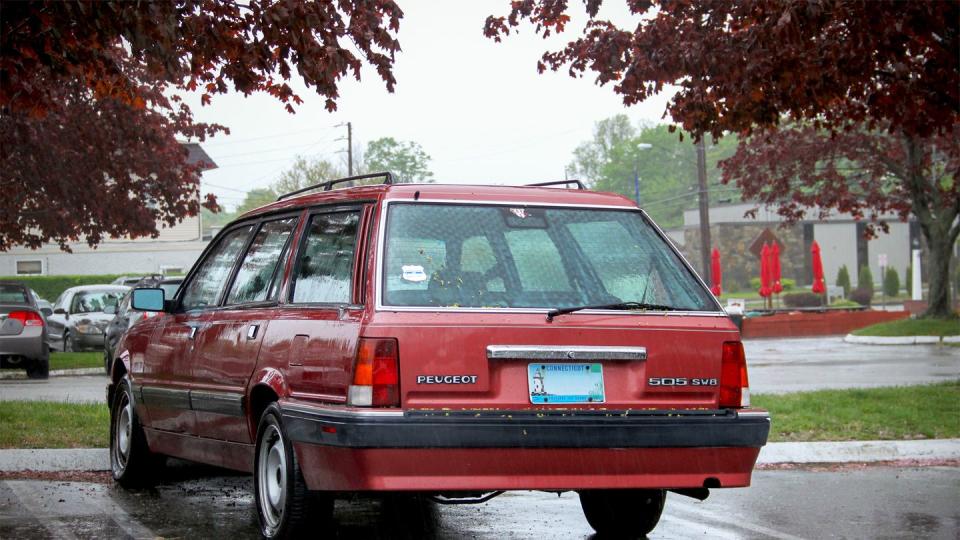Street-Spotted: Peugeot 505 SW8

Thirty-two years after Peugeot left the US, the 505 station wagon remains the model you're most likely to encounter on the road—assuming you encounter one at all, because there are just a couple hundred left in running condition.
The 505 was the French marque's best-seller in the 1980s, and while the sedan had its own merits, the 505 longroof was one of several French wagons sold in the US during that decade. Strange thing to think about now that there are zero.
First, there was the Renault 18i, which was more of a blip on the radar as AMC prepared to go all-in on Renault models during the second part of the decade. You could also import a Citroën CX station wagon and have it federalized by CXA Automotive in New Jersey, if you were feeling mechanically adventurous and were in need of a seriously large and plush longroof. Then there was Peugeot's own 504 station wagon, which was nowhere as popular as the sedan (which made it into New York taxi fleets in diesel form), but still an option.
Finally, there was the Renault Medallion which arrived just as Chrysler was in the process of buying the remains of AMC, so only about half a year's worth of Medallions were assembled with the Renault badge, later becoming the Eagle Medallion.
For a brief moment, the Peugeot 405 station wagon was also sold alongside the 505 wagon, though the former only saw about a thousand units find buyers stateside.
So the 505 wasn't even the largest or the most expensive French station wagon you could buy in the 1980s. But it was easily the sales leader in this category.
While the basic 505 debuted in 1978, the SW8, or station wagon with seating for eight, arrived a bit later, featuring a third row of seats.
These seats, however, were forward facing, and weren't really aimed at transporting adults. But then again, Peugeot was aiming this particular model as an alternative to large American station wagons that could carry little leaguers when pressed into service.
"Other wagon makers, however, force their third seat passengers to sit backwards, staring danger right in the face," Peugeot's ads of the time explained, which is an interesting way to think about it.

Not only could the third row of seats be folded down, but the second row could be tilted forward, buying the interior quite a bit of space. The load floor was not particularly low by modern standards, but it did permit the 505 SW8 to haul a lot of stuff.
With all the seats folded down, the 505 SW8 offered 68.5 cubic feet of interior cargo space. It lost in that category to some domestic galleons of the day like the Buick Caprice/Roadmaster, which served up 92 cubic feet, but it still analogous to something like a Volvo 240 of the time, which offered 67 cubic feet with the seats folded down.
Peugeot played up the safety features offered not just by the transparent size of the station wagon, but the engineering as well.
"Every 505 wagon we sell puts safety first. The entire passenger compartment is surrounded by a protective cage of cold-rolled steel," Peugeot's ads promised. "And it's separated from the front and rear end by 'crumple zones' that are designed to collapse on impact thereby absorbing the force of the collision."
This particular 505 SW8 was sold new at a Jeep-AMC-Renault-Peugeot dealer in Connecticut and remained a local car, living within just a couple of miles of that dealership. It was also one of about a dozen Peugeots from that dealership that remained on the road in the 2010s, which itself is a bit of miracle, considering the fact that the dealership closed down in the mid-2000s and had little interest in servicing the remaining Peugeots by the late 1990s.
"On top of all that, the SW8 provides the comforts of climate control, cruise control, heated front seats, central locking, rear-window wiper, and a formidable Peugeot 120-hp, overhead-cam engine," ad copy of the time promised.
The list of standard items was admittedly high for the time, but 120 hp also meant that a 2.1-liter inline-four resided underhood. The V6 was not on the menu for the wagons.
With Peugeot leaving the US in 1991, some buyers finally got some deals on these, because the 505 SW8 was also not an inexpensive choice among foreign cars.
Seeing this clean example reminded us of a time when these were a relatively common sight in the Northeast, with over a dozen Peugeot dealers just in Connecticut alone. But spotting one of these today is a tall order.

 Yahoo Autos
Yahoo Autos 